Fuerteventura
Thursday 31st March
Having not been abroad for over two years, there was a sense of anticipation as Gareth and I set off for Gatwick in the early hours of the morning. With the car left in the safe hands of Purple Parking and the usual airport formalities dispensed with, we were ready for take-off at 06:10 (25 minutes later than scheduled) for the 4-hour Easyjet flight to Fuerteventura for which wearing a face mask was mandatory. The all-important QR codes on our phones confirming that we were triple-vaccinated ensured that the arrivals process at the other end was very straightforward and in no time at all we were outside the arrivals hall and ready to pick up our hire car from Top Car – a Toyota C-HR hybrid automatic. Having acquainted myself with the controls of the car and remembered that I needed to drive on the right, we set off for Caleta del Fuste, a short 5km drive down the coast, seeing a Plain Swift on the way. We had a special reason for going there in that it had been home to a Red-billed Tropicbird which had been making periodic visits to the unlikely location of a pond by the Atlantico shopping centre since mid-March. Now was not the time for Google maps to fail us but eventually after one false start we found the right place where to our delight the Tropicbird was in residence sat just a few metres away on a rock around the edge of the pond. This was indeed fortunate as we knew that it had been erratic in its appearances, sometimes going missing for long periods. For the next 20 minutes or so we enjoyed fantastic views before it was disturbed by an incoming plane overhead and departed out to sea. Also on the pond were 2 Muscovy Ducks and a migrant Common Sandpiper.
By now lack of sleep was catching up with us so rather than head back to the car we opted for a sit-down lunch on the terrace of a waterside café which we shared with a ridiculously tame party of 13 Turnstone. Also seen from the terrace were 2 passing Cory’s Shearwaters (one fairly close), 16 Gannets, the inevitable Yellow-legged Gulls and the return of the Tropicbird which appeared from the south, did a few circuits and dropped into the same pond where we’d seen it earlier. Now it was even closer than before and, when it finally flew again, this time it did several circuits of the pond and passed over our heads at low level showing off its outrageous long white tail. A brilliant start to our stay on Fuenteventura and one that was going to be hard to beat. On the way back to the car we stopped to look at a roost of about 50 Sandwich Terns on the rocky foreshore but couldn’t find anything with them.
Just down the coast from Caleta del Fuste is Las Salinas, an area of saltpans currently being restored where a short stop revealed a handful of waders - 2 Black-winged Stilts, Greenshank and Redshank on the pans and 5 Whimbrel and 2 more Common Sandpipers on the adjacent rocky shore. Also seen were the first of many (a pair) of Berthelot’s Pipits and 4 Barbary Ground Squirrels.
With time to kill before we could pick up the keys to our accommodation at La Oliva, we decided to head inland and visit Los Molinos, the largest body of freshwater on Fuenteventura and the only one that never dries up even in a very dry winter like the one the eastern Canary Islands has just had. Before driving out along the dirt track to the reservoir, we had another refreshment stop at the coastal hamlet of Puertito de los Molinos, reputedly a good site for Fuerteventura Stonechat though all we could find were more Berthelot’s Pipits and a ridiculous number of Muscovy Ducks on the stream by the parking area. The reservoir itself was better despite the blustery conditions, the highlight being superb views of a pair of Egyptian Vultures. Also seen were 17 Ruddy Shelducks, a Coot, 4 Black-winged Stilts and a Greenshank on the reservoir, 2 Black-bellied Sandgrouse flying over, 4 Rock Doves, 3 Ravens, and a pair of Ruddy Shelduck with 12 small ducklings along the access track.
From Los Molinos it was about a 20 minute drive to the quiet village of La Oliva where we met Pedro, owner of GBH Casas Las Portadas, our base for the next 3 nights. A comfortable and traditional Canarian villa with separate bedrooms, our only slight complaints being that the WiFi was ‘down’ and there was no kettle or microwave. A pair of Stone-curlew was seen flying over at dusk and later heard calling.
Friday 1st April
I was up by 06:00 but could have stayed in bed for longer had I known that sunrise was not due until 07:50. By 07:30 we were on the stony Tindaya plain, a well-known ‘hotspot’ for Houbara Bustard, Cream-coloured Courser and other desert birds. Rather than tramping across the plain, the best tactic is to slowly drive the network of roads, stopping and scanning at regular intervals usually to look at rocks that were pretending to be birds! We had been assured that Houbara would be ‘easy’ due to the dry conditions forcing birds to forage along the roadsides but in the first hour after sunrise we’d seen just the one very distant bird plus a pair of Black-bellied Sandgrouse, a Hoopoe, 3 Lesser Short-toed Larks and 2 Trumpeter Finches. Eventually a Houbara walked across the road in front of the car and, having seen one, we were then treated to some excellent views of these elegant birds with their distinctive black stripe on the side of the neck, strutting across the plain. However, despite much scanning of areas where coursers had been seen in early March, we drew a blank and rather worryingly spoke to a couple of Spanish birders who hadn’t seen any at Tindaya in four days of searching. Final totals for the morning were Ruddy Shelduck (6), Houbara Bustard (9), Black-bellied Sandgrouse (13), Swallow (2), Lesser Short-toed Lark (8), Raven (1), Berthelot’s Pipit (2) and Trumpeter Finch (3) though some duplication is likely, especially with the bustards.
Having spent the morning on the plains, we were in need of a change of scenery and opted for the pretty little town of Betancuria where there are cultivated fields and more trees than most other parts of the island. A nice selection of birds here included singles of Common Buzzard and Kestrel, Stone-curlew (h), 2 Laughing Doves, 3 Great Grey Shrikes, 2 African Blue Tits, 5 Atlantic Canaries (a scarce bird on Fuerteventura) and, over lunch, a very tame pair of Sardinian Warblers, the male perching briefly on a chair on the restaurant terrace. On the way back north, we stopped at the Morro Velosa viewpoint (650m above sea level) where, despite the wind, we admired the spectacular views across the interior of the island.
Fuerteventura is the only place in the world where Fuerteventura Chat occurs. The best known site is the Barranco de Rio Cabras now most easily accessed from the upper end due to the construction of a motorway along the coast. A couple of hours here late afternoon proved to be very rewarding with excellent views of a total of 5 Fuerteventura Stonechats, including a tame pair that came to investigate us, plus a presumed family party of 5 Egyptian Vultures, a pair of Little Ringed Plovers, a total of 6 Turtle Doves, 4 Laughing Doves, a Plain Swift, a Hoopoe, 2 House Martins, an African Blue Tit, a singing Spectacled Warbler, 2 Ravens and the now inevitable Berthelot’s Pipits and Spanish Sparrows.
Even though we’d been out since well before sunrise, there was still time for another circuit of the Tindaya Plain which again failed to produce any coursers though we did see another 4 Houbara Bustards. A Stone-curlew in fading light in the back garden of the villa finished an excellent day off nicely.
Saturday 2nd April
Having looked at recent images of Coursers taken at Los Molinos, Gareth was confident that he knew roughly where they’d been taken and the area where we should be concentrating our search today. After an early breakfast at the bakery in La Oliva while it was still dark, we parked up along the track from Las Parcelas to the reservoir at Los Molinos and set out on foot on to the stony plain to the east walking back towards the village where there was a pair of Trumpeter Finches, the male singing its peculiar nasal, buzzing song – something I hadn’t heard before. After a couple of hours of plodding across the plain, it was beginning to look as if our early optimism was misplaced though the unexpected appearance of a single Houbara Bustard plus totals of 3 Stone-curlews and 7 Black-bellied Sandgrouse gave us some hope to cling to. Eventually, having split up and gone off in different directions, I could see Gareth waving frantically so I legged it over to where he was standing to find him watching a very mobile Cream-coloured Courser. It was some distance away and although it did allow us to get closer to it, it was constantly on the move and showing no signs of settling down to feed. Rather than chase after it, we decided to sit down and see if the bird would come to us, a tactic that worked a treat with it coming closer and closer to us before settling down in a depression where from its’ behaviour it clearly had a nest. It did not seem at all bothered by our presence, allowing Gareth to rattle off some photographs before we retreated and left in peace. A great bird and another contender for bird of the trip. We then tried the reservoir where there were 50 Ruddy Shelducks, a Grey Heron, a Coot, 2 Black-winged Stilts, 2 Little Ringed Plovers, a pair of Fuerteventura Stonechats (around the dam), showy Spanish Sparrows on the fence by the parking area and 3 Trumpeter Finches.
Our next stop was the low rocky coast at Faro de Toston north of El Cortillo where a good list of birds comprised 5 Gannets, 5 Little Egrets, 2 Spoonbills, a Stone-curlew, 12 Ringed & 10 Kentish Plovers, 35 Sanderling, 4 Turnstone, 2 Dunlin, a Common Sandpiper, 4 Whimbrel, a Lesser Black-backed Gull, a Great Grey Shrike and Berthelot’s Pipit. We then tried the resort of Corralejo where there had been a Ring-billed Gull in early March but not knowing exactly where it had been seen, we were unable to find it. Despite it being busy with tourists, there was a good selection of waders here too made up of 27 Ringed & 13 Grey Plovers, 27 Sanderling, 9 Turnstone, a Common Sandpiper, 3 Bar-tailed Godwits and 31 Whimbrel. Also seen were a Swallow and a Spanish Sparrow.
Rather than take the new motorway back to La Oliva, we continued south along the scenic coast to Casas de las Llanadas before turning inland where there was still time to visit Barranco de los Caleros close to La Oliva. Unfortunately, like everywhere else on the island, it was very dry with no water at all though we still managed to see 3 Ruddy Shelducks, a Stone-curlew, a Black-bellied Sandgrouse, a pair of Fuerteventura Stonechats, 5 Berthelot’s Pipits, 3 Spanish Sparrows and a good total of 11 Trumpeter Finches.
Sunday 3rd April
Having now seen just about all the birds we’d hoped for, we decided to spend our last day at the southern end of the island, an area I hadn’t visited before. A few birds on the drive down there included 2 Barbary Partridge flushed off the road near Diego Alonso and 2 Black-winged Stilts, 2 Little Ringed Plovers, a Green Sandpiper and a family of Ruddy Shelduck on a roadside pond at La Calabaza. Our first stop was at the Playa de Sotavento, an extensive sandy beach south of Costa Calma. We had high hopes of seeing Audouin’s Gull here but the only gulls we could find with the tide out were Yellow-legged and Lesser Black-backed (12) plus a Spoonbill, 2 Little Egrets, 21 Sanderling, 3 Whimbrel and a Raven. We then tried the lagoon near the Hotel los Gorriones where there were another 4 Spoonbills and a handful of distant gulls which were flushed by a helicopter before we could get near them. In the low scrub behind the parking area were 2 Lesser Short-toed Larks, 2 Spectacled Warblers and a pair of Berthelot’s Pipits.
The Gosney guide to The Canaries mentions the area around the Oasis Park zoo at La Lajita as being good for migrants and for a number of free-flying exotics such as Red-vented Bulbul which originated from the zoo. Unfortunately, it was heaving with people when we visited and there was no sign of anything remotely noteworthy bar 4 Grey Herons, an Egyptian Vulture that appeared to be radio-tagged and our only Linnets of the trip in the garden centre adjacent to the zoo. The zoo does claim to have a wildlife area though at 35€ per person to get in we weren’t about to find out if it was any good or not!
The rest of the day was a bit of a non-event with the wind picking up significantly and dark clouds building overhead. The Barranco de la Torre was all but birdless in the gusty conditions as were the saltpans at Las Salinas and, at Caleta del Fuste, the Tropicbird had gone AWOL with no sign of it on the pond by the Atlantico shopping centre in two attempts though the Common Sandpiper was still there. The windy conditions were however perfect for Cory’s Shearwaters with at least 50 offshore at Caleta del Fuste, most fairly distant but the odd one passing closer in.
Our flight home scheduled for 20:00 departed over an hour late with Easyjet’s so-called bistro service restricted to cold drinks from the bottle or can (no cups) and Pringles due apparently to a change of supplier. We landed at Gatwick at 01:15 and were back in Southwick by 03:00 at the end of what had been an excellent few days away. I’m already thinking about where we should go next year!


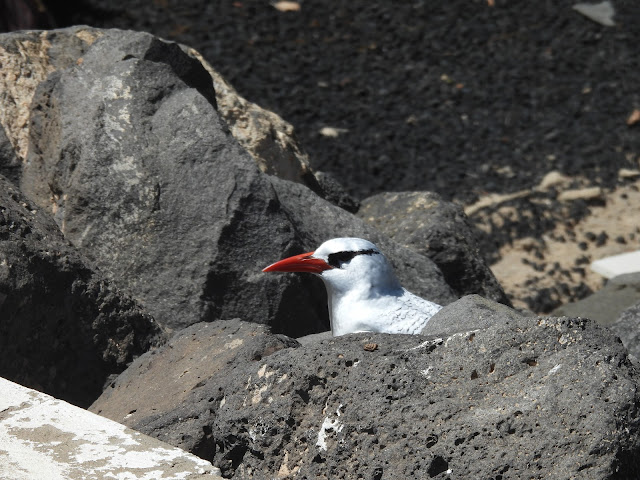













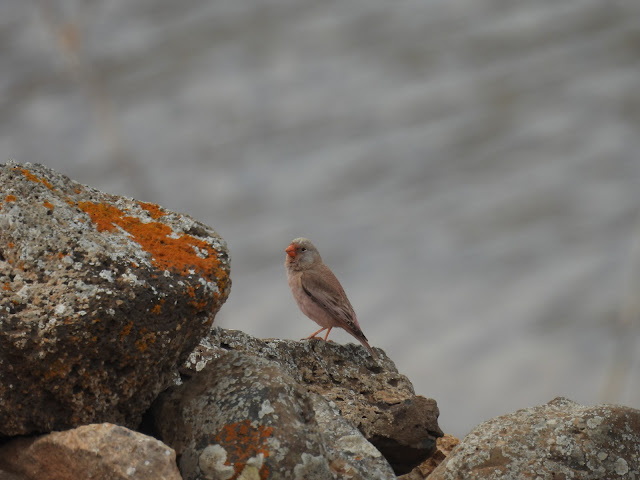

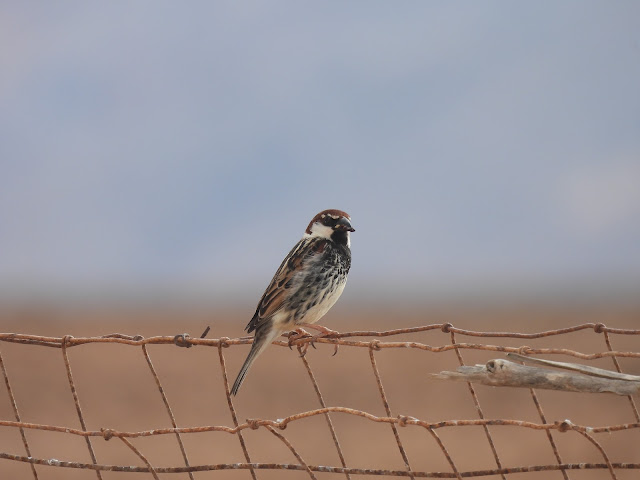




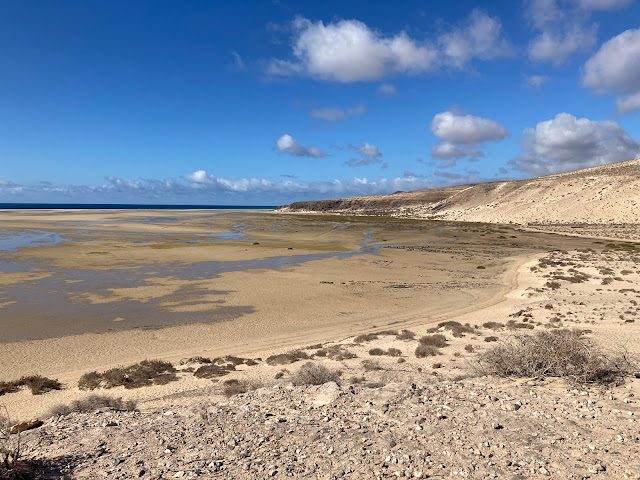
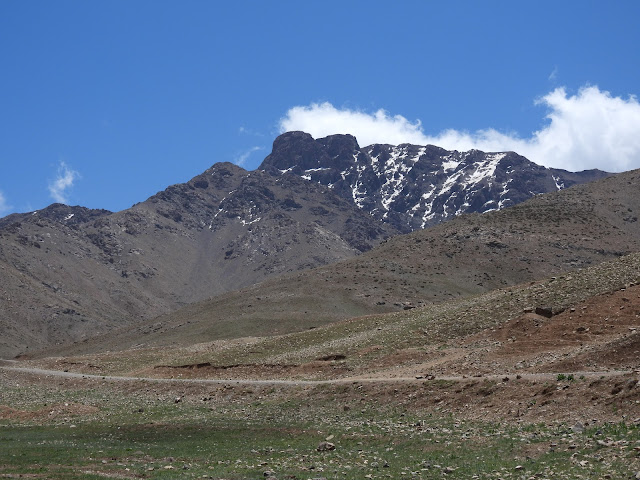


Comments
Post a Comment